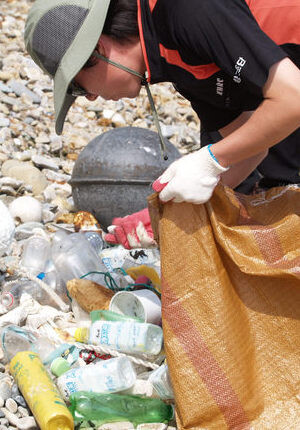hankyoreh
Links to other country sites 다른 나라 사이트 링크
Foreign trash litters Korean shores, recent study finds

Recent research revealed that one out of eight pieces of trash recovered on South Korea’s west and south coasts was from overseas.
The fact was revealed by a research survey done on 12 coastal islands, taken by the Korea Rescue Center last year. An uninhabited island west of Jeju Island, Chagui Island, was found to receive the largest amount of foreign waste, with 34.2 percent of total garbage carried from other shores. The overall average of foreign garbage stood at 12.5 percent, but the average on the west coast was 13.3 percent, nearly double the south coast’s average of 7.1 percent.
South Korea began a survey of sea waste from overseas in 2003, but it was the first time the survey was conducted on a national scale.
About 72 percent of foreign-originated sea waste recovered in the survey was plastic bottles and buoys. The rest was medicine bottles, shoes, lighters and other. In particular, a significant number of Chinese medicine bottles was found, suggesting inappropriately-processed medical wastes are affecting South Korea.
China was the primary source of the ocean-borne garbage, followed by Taiwan, Japan, Malaysia, Vietnam, Hong Kong, Russia, Indonesia, the U.S., Britain, the Netherlands, and the Philippines.
South Korean refuse is no stranger to foreign shores, either. Japan has become particularly sensitive regarding an inflow of Korean sea waste.
In 2003 and 2005, Japan sent marine security officials to South Korea’s Ministry of Maritime and Fisheries to ask Seoul to set up countermeasures regarding the influx of sea waste from Korean shores.
In one Japanese prefecture, Ishikawa, about 38 percent of the total garbage washed up came from South Korea, according to a research survey. Only seven percent of the waste was from China and Thailand.
In another Japanese prefecture called Kanakawa, about 70 percent of plastic waste came from overseas and of that waste, 80 percent originated from North and South Korea.
In 2001, one northern coastal area of Brazil found waste from 48 countries on five continents, including South Korean bottles.
Hong Seon-wook, the Korea Rescue Center official who led the survey, said that "it is desirable for South Korea, China and Japan, which have different roles in governments and private bodies, to take steps to reduce waste, with the attitude of learning from each other."
Sea waste is moved mainly by the waves and wind. Just as the ’yellow dust’ loaded with heavy metals moves from China to the Pacific Ocean via South Korea and Japan, garbage tracks a similar route. The survey showed that South Korea is both a final destination and transit point for Chinese sea waste.
Editorial・opinion
![[Column] Park Geun-hye déjà vu in Yoon Suk-yeol [Column] Park Geun-hye déjà vu in Yoon Suk-yeol](https://flexible.img.hani.co.kr/flexible/normal/500/300/imgdb/original/2024/0424/651713945113788.jpg) [Column] Park Geun-hye déjà vu in Yoon Suk-yeol
[Column] Park Geun-hye déjà vu in Yoon Suk-yeol![[Editorial] New weight of N. Korea’s nuclear threats makes dialogue all the more urgent [Editorial] New weight of N. Korea’s nuclear threats makes dialogue all the more urgent](https://flexible.img.hani.co.kr/flexible/normal/500/300/imgdb/original/2024/0424/7317139454662664.jpg) [Editorial] New weight of N. Korea’s nuclear threats makes dialogue all the more urgent
[Editorial] New weight of N. Korea’s nuclear threats makes dialogue all the more urgent- [Guest essay] The real reason Korea’s new right wants to dub Rhee a founding father
- [Column] ‘Choson’: Is it time we start referring to N. Korea in its own terms?
- [Editorial] Japan’s rewriting of history with Korea has gone too far
- [Column] The president’s questionable capacity for dialogue
- [Column] Are chaebol firms just pizza pies for families to divvy up as they please?
- [Column] Has Korea, too, crossed the Rubicon on China?
- [Correspondent’s column] In Japan’s alliance with US, echoes of its past alliances with UK
- [Editorial] Does Yoon think the Korean public is wrong?
Most viewed articles
- 1‘We must say no’: Seoul defense chief on Korean, USFK involvement in hypothetical Taiwan crisis
- 2Will NewJeans end up collateral damage in internal feud at K-pop juggernaut Hybe?
- 3[Column] Park Geun-hye déjà vu in Yoon Suk-yeol
- 4Why Korea shouldn’t welcome Japan’s newly beefed up defense cooperation with US
- 5Thursday to mark start of resignations by senior doctors amid standoff with government
- 6N. Korean hackers breached 10 defense contractors in South for months, police say
- 7[Guest essay] The real reason Korea’s new right wants to dub Rhee a founding father
- 8[Column] ‘Choson’: Is it time we start referring to N. Korea in its own terms?
- 9Kim Jong-un expressed ‘satisfaction’ with nuclear counterstrike drill directed at South
- 10[Editorial] New weight of N. Korea’s nuclear threats makes dialogue all the more urgent